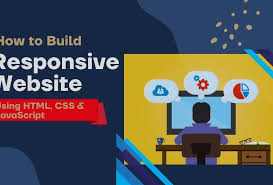In today's mobile-first world, having a responsive website is no longer optional—it's essential. A responsive website adjusts its layout and content based on the screen size and device, providing an optimal user experience whether you're on a phone, tablet, or desktop. In this article, we'll walk you through how to build a basic responsive website using HTML, CSS, and JavaScript in 2025.
1. Setting Up Your Project Structure
Start with a simple project structure:
project-folder/
|-- index.html
|-- style.css
|-- script.js
This keeps your HTML, CSS, and JavaScript organized.
2. Create the HTML Layout
Start with a semantic structure:
<!DOCTYPE html>
<html lang="en">
<head>
<meta charset="UTF-8">
<meta name="viewport" content="width=device-width, initial-scale=1.0">
<title>Responsive Website</title>
<link rel="stylesheet" href="style.css">
</head>
<body>
<header>
<h1>My Responsive Site</h1>
<nav>
<ul>
<li><a href="#">Home</a></li>
<li><a href="#">About</a></li>
<li><a href="#">Contact</a></li>
</ul>
</nav>
</header>
<main>
<section class="intro">
<h2>Welcome</h2>
<p>This is a simple responsive website layout.</p>
</section>
</main>
<footer>
<p>© 2025 My Site</p>
</footer>
<script src="script.js"></script>
</body>
</html>
3. Add Responsive CSS
/* style.css */
body {
font-family: Arial, sans-serif;
margin: 0;
padding: 0;
}
header {
background: #333;
color: #fff;
padding: 1rem;
}
nav ul {
list-style: none;
display: flex;
gap: 1rem;
}
nav a {
color: white;
text-decoration: none;
}
main {
padding: 1rem;
}
/* Responsive layout */
@media (max-width: 768px) {
nav ul {
flex-direction: column;
}
}
4. Enhance with JavaScript (Optional)
Add interactivity, such as a toggle menu for mobile view:
// script.js
document.addEventListener('DOMContentLoaded', () => {
const nav = document.querySelector('nav ul');
const toggle = document.createElement('button');
toggle.textContent = 'Menu';
document.querySelector('nav').prepend(toggle);
toggle.addEventListener('click', () => {
nav.classList.toggle('open');
});
});
Add styles for .open in CSS if needed.
5. Test and Optimize
- Use Chrome DevTools or Firefox Developer Tools to test responsiveness.
- Make sure the layout works on all screen sizes.
- Minify CSS and JS for faster load times.
Responsive design improves user experience and SEO. With HTML for structure, CSS for styling, and JavaScript for interactivity, you can build a responsive website that looks great and performs well on any device. Keep practicing by adding images, forms, and additional sections.
Need more? Subscribe to our blog for tutorials, tips, and modern web development tricks in 2025!
